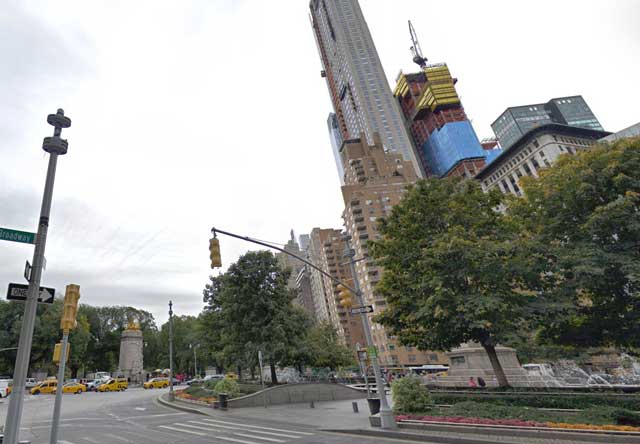Columbus Circle, NY
 |
| Columbus Circle, NYC, in the 1970s. I think this gritty, dirty photo is an absolutely perfect way to sum up the state of Columbus Circle in the 1970s. The whole area had become an eyesore. |
If you are driving to New York City from anywhere else, you will regular road signs giving you the distance to the city. So, you'll be 200 miles away, then 175, and so forth. Those distances are measured not from the outskirts of New York City, but from one specific location: Columbus Circle. Literally the heart of New York City (at least according to the federal government, Google uses City Hall), Columbus Circle also for a long time was extremely neglected. It had a huge, drab convention center behind it, the monument to Columbus, and a lot of cars whizzing by going somewhere else. Seeing the above photo from the 1970s of Columbus Circle looking toward the East gave me the idea of seeing how it looks now. So, this is
a comparison of Columbus Circle from the 1970s to 2018.
 |
| Columbus Circle in November 2017 (Google Street View). |
Columbus Circle has retained its essential elements such as the monument, but otherwise is a drastically different place than it was in the 1970s. The circle was renovated in the 1990s and then between 2003 and 2005 to separate the monument from traffic with a much larger traffic island and an array of fountains. The new park has won awards and has made Columbus Circle a destination rather than something to just drive around, as can be seen in the 1970s photo above.
The area to the west of Columbus Circle has seen huge changes over the years, too. In the early 20th Century, all that was there was the monument, and traffic just drove right by it. At a time with less traffic and more foot traffic, this worked fine. There was a massive - for the time - building near the monument which helped to create a defined space for the monument and corraled the traffic flow into an actual circle.
 |
| Columbus Circle ca. 1990. The New York Coliseum is in the center of the photo. This clearly shows how traffic simply drove by the Christopher Columbus monument and how difficult it was to even get to it. |
Unfortunately, in the 1950s they tore down the area behind Columbus Circle and erected the New York Coliseum, a convention center. While a perfectly functional building (they held the annual Boat Show there), the Coliseum provided an unimpressive backdrop to the area. It also blocked access from the west, an odd choice to make, and made the area into a dead zone when there wasn't anything going on in the Coliseum (which was the vast majority of the time). The area looked almost abandoned during the day and the area in front of the Coliseum like an abandoned car lot. There literally was nothing to do there during the day - no shopping, no eateries, nowhere to sit. Well, nothing to do unless you were homeless, that is, as a lot of them camped out there. It was a strange way to treat the heart of your city. The opening of the Jacob Javits Center on the West Side in 1986 removed that last shred of usefulness for the Coliseum, The Coliseum's owner, the Metropolitan Transportation Authority (MTA), knew the Coliseum was becoming a problem and put the Coliseum on the market in 1984. It took well over a decade to sell due to issues in the New York City real estate market (such as the usual community opposition to various plans which reduced the site's value to some developers). Some bidders dropped out because the city seemed half-hearted about actually doing something about the site.
 |
| Columbus Circle in 2018, looking west. |
Finally, in 1998, the MTA sold the Coliseum to a joint venture of Time Warner and The Related Companies for $345 million. The Coliseum was demolished in 2000 and the Time Warner Center went up in its place. This undeniably was a huge improvement from an aesthetic point of view. Now, Columbus Circle is a destination again where people live and work and you can shop and eat and relax. Development nearby on Central Park South also has been energized. While the basic layout of the monument, the nearby entrance to Central Park, and nearby buildings remains intact, the meaning and usefulness of the area have been transformed. It was sort of addition by subtraction, and then some addition by addition by the replacement of a crumbling eyesore with buildings that enhanced the location rather than detracted from it.
 |
| The Christopher Columbus monument once again seems to fit it into surroundings (Google Street View). |
I hope you enjoyed this entry in my "the more things change, the more they stay the same." Please visit some of my other entries in this series, where we explore the gradual evolution of a city from small decisions made over time.
2019






No comments:
Post a Comment
Note: Only a member of this blog may post a comment.